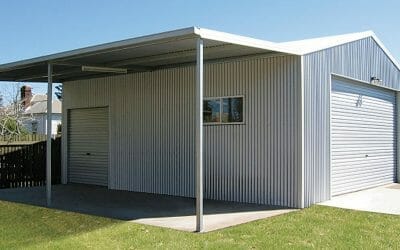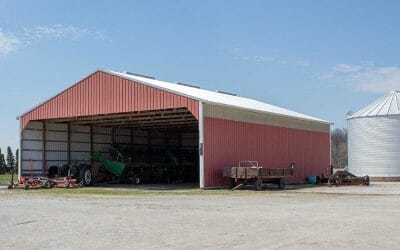My Shed’s Damp- Help!
Have you noticed condensation forming on the ceiling of your shed? This build up of moisture can occur in all types of sheds from garden sheds to farm sheds and even large commercial sheds. It usually occurs when the roof material becomes colder than the air inside your shed. When the water vapour in the air meets the cold surface, it condenses into water droplets.
ALSO READ – RURAL & FARM SHED PERMITS

Why Is Moisture In A Shed Bad?
Moisture build up can lead to several issues down the road, so it’s important to try and prevent it. Firstly, moisture can lead to costly damage of tools or materials inside the shed, including the materials that the shed is made from. Secondly, excess moisture can lead to mould and mildew problems, creating an unhealthy environment inside your shed.
How Do You Stop Dampness In A Shed?
To avoid condensation and moisture build up in your shed, there are a number of strategies that can help. Use a combination of the strategies below for the best results.
1. Insulate
Insulation not only makes your shed more energy efficient by reducing heat gain and loss, it also raises the surface temperature which helps prevent condensation. Insulation products with a closed-cell foam structure and a reflective foil surface, such as Kingspan’s AIR-CELL Insulshed 50, perform very well as a vapour barrier.
2. Seal Up Leaks
Anywhere there is a gap or leak in your shed is an opportunity for moisture to creep in. If you are having moisture issues, inspect your shed for leakages. Pay special attention to the roof joints, anywhere there are water pipes and the shed base where the floor meets the walls. If you find any drips, condensation or wet spots, you may need to reseal the affected areas.
3. Ventilate
Adequate air circulation in your shed is crucial for preventing moisture build up. You can improve the ventilation in your shed by installing windows and vents, which help replace stuffy, moist air passively. Whirlybirds and fans are also good at helping improve the circulation of air to reduce moisture build up.
4. Let The Air Flow
Try and leave space around the objects in your shed so that air can flow around them. Using open shelves lets air get in and around the items in your shed, which can reduce the risk of moisture build up. In addition, try and leave a gap between the wall and your shed items to improve air circulation.
5. Use A Concrete Vapour Barrier
Vapour barriers are sheets of black plastic that are placed underneath the concrete base of a shed. They act as a barrier between the soil and your shed, to prevent moisture creeping up through the concrete slab into your shed.
6. Build Your Shed Correctly
Effective moisture prevention starts with a good foundation and a quality build. If you haven’t yet built your shed or are thinking about replacing an old shed, it’s important that you don’t cut corners as a poorly built shed can amplify moisture problems. To avoid the discomforts and costly damage moisture can cause, it’s best to speak with a professional. At Spinifex Sheds, we build quality residential, commercial and farm sheds in Perth. Get in touch with our team today to see how we can help you create a moisture-proof shed.
Similar Articles
Preparing Your Site for a Shed | 8 Essential Steps for a Successful Installation
The process of installing a new shed involves more than just the construction of the structure itself. A crucial preliminary step is to prepare your shed site for construction. Laying the groundwork properly can make the difference between a shed that stands strong...
Are Shed Kits Worth It? Comparing DIY vs Project-Managed Shed Builds
DIY sheds and project-managed shed builds are two different approaches to constructing a shed, each with its own advantages and considerations. DIY sheds, as the name suggests, involve the owner taking on the construction process themselves. This involves getting a...
How to Build a Farm Shed | Tips from Expert Shed Builders
Farm sheds are essential for many agricultural and rural properties, as they offer storage, workspace, and shelter for farm equipment, animals, and more. However, building a functional and attractive structure is not always an easy task.Today we'll walk you through...






